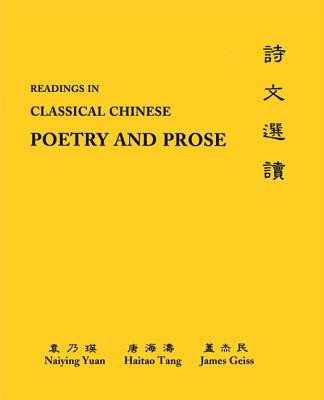
- We will send in 10–14 business days.
- Author: Naiying Yuan
- Publisher: Princeton University Press
- ISBN-10: 0691118329
- ISBN-13: 9780691118321
- Format: 21.6 x 27.8 x 1.8 cm, minkšti viršeliai
- Language: English
- SAVE -10% with code: EXTRA
Reviews
Description
This supplemental volume continues the rigorous standard set forth in the main, three-volume Classical Chinese: A Basic Reader while reinforcing its linguistic lessons from carefully chosen representative works. Comprised of three parts--"Poetry," "Lyrics," and "Prose"--it presents texts, chronologically, that represent the artistic embodiment of China's Confucian and Taoist thought. Two introductions separately describe the structural and formal features of regulated verse and parallel prose; each genre is unique to Chinese literature yet both share common characteristics tempered by the Chinese language.
The main text and its four supplementary volumes together represent the most comprehensive and authoritative textbook on the language, literature, philosophy, history, and religion of premodern China. Field-tested and fine-tuned for years in classroom settings by three members of the Chinese Linguistics Project at Princeton University, it is the definitive new resource for students and instructors of classical Chinese language or culture.EXTRA 10 % discount with code: EXTRA
The promotion ends in 23d.07:29:52
The discount code is valid when purchasing from 10 €. Discounts do not stack.
- Author: Naiying Yuan
- Publisher: Princeton University Press
- ISBN-10: 0691118329
- ISBN-13: 9780691118321
- Format: 21.6 x 27.8 x 1.8 cm, minkšti viršeliai
- Language: English English
This supplemental volume continues the rigorous standard set forth in the main, three-volume Classical Chinese: A Basic Reader while reinforcing its linguistic lessons from carefully chosen representative works. Comprised of three parts--"Poetry," "Lyrics," and "Prose"--it presents texts, chronologically, that represent the artistic embodiment of China's Confucian and Taoist thought. Two introductions separately describe the structural and formal features of regulated verse and parallel prose; each genre is unique to Chinese literature yet both share common characteristics tempered by the Chinese language.
The main text and its four supplementary volumes together represent the most comprehensive and authoritative textbook on the language, literature, philosophy, history, and religion of premodern China. Field-tested and fine-tuned for years in classroom settings by three members of the Chinese Linguistics Project at Princeton University, it is the definitive new resource for students and instructors of classical Chinese language or culture.

Reviews